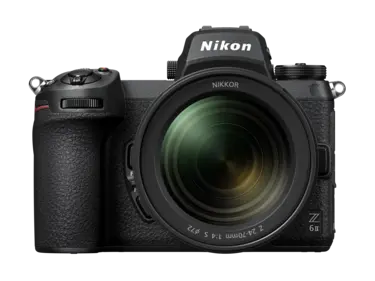How to become a content creator on YouTube

From picking the right gear to navigating algorithms, what’s the best way to become a content creator? John Bogna weighs in
YouTube has come far from its humble beginnings as a video-sharing site in 2005. Now millions of users rack up billions of views, making videos on everything from cooking to comics. If you’ve thought about creating content on YouTube but aren’t sure where to start, read on.
While there’s no set path to becoming a content creator on any platform, there are things you can do to give yourself a better chance.
Let’s start with the most obvious: the gear.
Build your YouTube content creation set-up
The camera
The Nikon Z30 and Nikon Zfc are excellent budget options. Both come with kit zoom lenses to cover multiple focal lengths. Both are crop-sensor (or DX) cameras, meaning their sensors aren’t as large as pro cameras but will still deliver excellent results.
The new Nikon Z50II is the latest DX camera in the range and has advanced features, including a dedicated Picture Control button to cycle through image ‘recipes’ to create different looks (for stills and video), autofocus and subject detection equivalent to the flagship Z9! Vlogging features include the new Product Review mode (shown above), which automatically focuses on an object held up to the lens, giving the ability to zoom even with a fixed prime lens and livestream direct from USB to laptop or smartphone – no extra software required. The Z50II can record in N-Log for a more professional look to videos for grading, too.
All three camera bodies have a vari-angle screen that’s ideal for recording yourself, and the Zfc and Z30 even come as a vlogging kit.
Another step up from those are FX cameras such as the Nikon Zf and Nikon Z5. Both are full frame, meaning they have larger sensors capable of capturing more data. These also come with versatile kit lenses.
Any one of the cameras above will let you record 4K video, which is fast becoming the standard for professional-looking YouTube videos. Full-frame cameras offer more extras for their higher price tag, such as more features and video format options.
If you want even more features and don’t mind spending a little extra, try the Nikon Z6III. It records up to 6K video and has line inputs to attach high-quality sound equipment such as a pro shotgun microphone. And, of course, it has the all-important flip-out screen.

Quick guide to Nikon’s latest powerzoom
Click the button to play
The lenses
If you only have money for a camera kit, the lens that comes with it is a great option. Lenses such as the NIKKOR Z DX 12-28mm f/3.5-5.6 PZ VR (powerzoom shown in the above video) and NIKKOR Z DX 16-50mm f/3.5-6.3 VR cover a range of wide-to-standard focal lengths with a reasonably large aperture. They’re DX (crop sensor) lenses designed for DX cameras.
Once you’ve learned your gear and have a feel for focal lengths and filming angles, you can step up to more specialised lenses. Prime lenses with a wider aperture, such as the NIKKOR Z 35mm f/1.4 and NIKKOR Z 50mm f/1.8 S, are workhorse lenses excellent for video and still photography.
After that, you can upgrade to even better lenses to push your images to the next level. Zoom lenses such as the NIKKOR Z 24-70mm f/2.8 S and wide-angle primes including the NIKKOR Z 24mm f/1.8 S are great for video, especially close-up vlogging. Pricewise, these lenses are on the high end. They are pro-level, so don’t feel pressured to buy them before you start creating videos. Consider them ‘nice to have’ lenses you’ll buy eventually.
If you’re working on a budget, get a versatile lens you can use for various shots and still images. 35mm and 50mm lenses that cover a fairly standard field of view are good choices here. Zoom kit lenses will also work, such as the NIKKOR Z 24-70mm f/4 S.
Read more: How many lenses do I need?

Learn your gear
You can start with your camera in full Auto mode, but you’ll eventually want to learn Manual mode to take full control of your settings. Some basic indoor videography guidelines include:
- Use a low ISO to avoid excessive noise, 100 if possible
- Use Kelvin settings (k) for your White Balance: 6000k indoors, 5500k outside, 3500k for golden hour
- 24 frames per second (fps) is a common setting for filming high-quality video. Your shutter speed will be twice the fps, so 1/50th shutter speed = 24fps
- Use a narrow aperture (higher number) for sharp focus and a wider aperture (lower number) for a blurrier, more dreamlike feel
Use these as a starting point to play around with and bend the rules as you learn.
Get a tripod to stabilise your camera if you can. If you don’t have one, use a stable surface such as a tabletop, stool or book to rest the camera on when filming. This gives your images a more grounded and professional look than handheld (unless you’re going for the handheld look).
Eye-tracking or face-tracking autofocus is highly recommended. If your camera has it, learn to use it. You’ll be frustrated by out-of-focus shots far less often.
Read more: 10 must-have accessories for your Nikon Z mirrorless camera

Cathrin Manning: Unboxing the *new* Nikon Z 30 + sharing the settings I use to film my videos
Click the button to play
Plan your channel
If you want your channel to grow, you need a strategic approach. Find your audience. Nail down your niche. Determine a content schedule that works for you. And then start making videos.
YouTube has resources on content strategy and finding an audience. Review them to learn the metrics and how they work. Study what makes YouTube more likely to recommend your content.
Pay attention to trends and what the algorithm wants. Know your audience. But don’t let those things completely dictate the content you make. Find a balance between creating for yourself and playing to the algorithm.
Figure out how long it takes to make a good piece of content you’re happy with, then how many of those you can make per week or month. Use that information to make a consistent posting schedule. Build in time for rest, especially if you’re creating content on top of a day job.
Most importantly: start making videos. Play, experiment, and find out what you enjoy doing. Your enthusiasm will resonate with viewers and they’ll want to follow your journey. See what the creators you follow are doing and what parts of their strategy you can use. Then settle in for the long haul, because it won’t happen overnight.
And there you have it: the beginner’s guide to YouTube content creation. Good luck and have fun!
More in Tips and Tricks
Featured products
Content creation 101
How to become a content creator on Instagram
A beginner’s guide to TikTok content creation (plus settings for mirrorless cameras)

Unlock greater creativity














